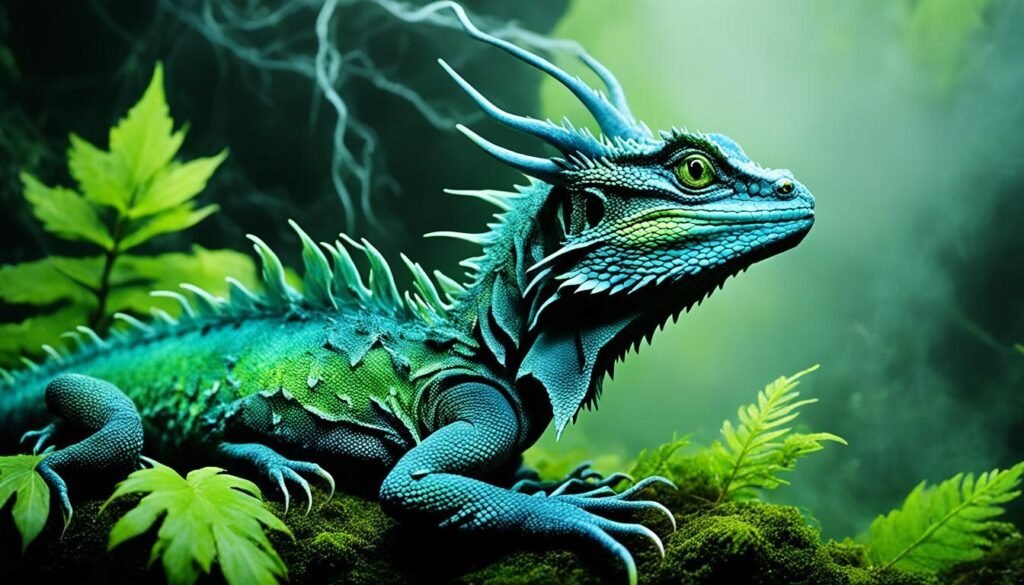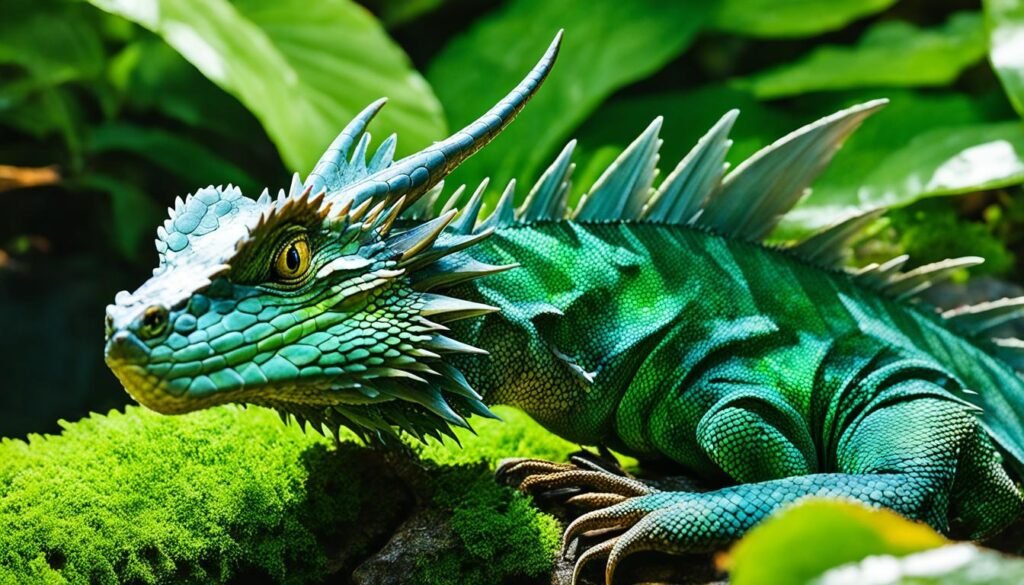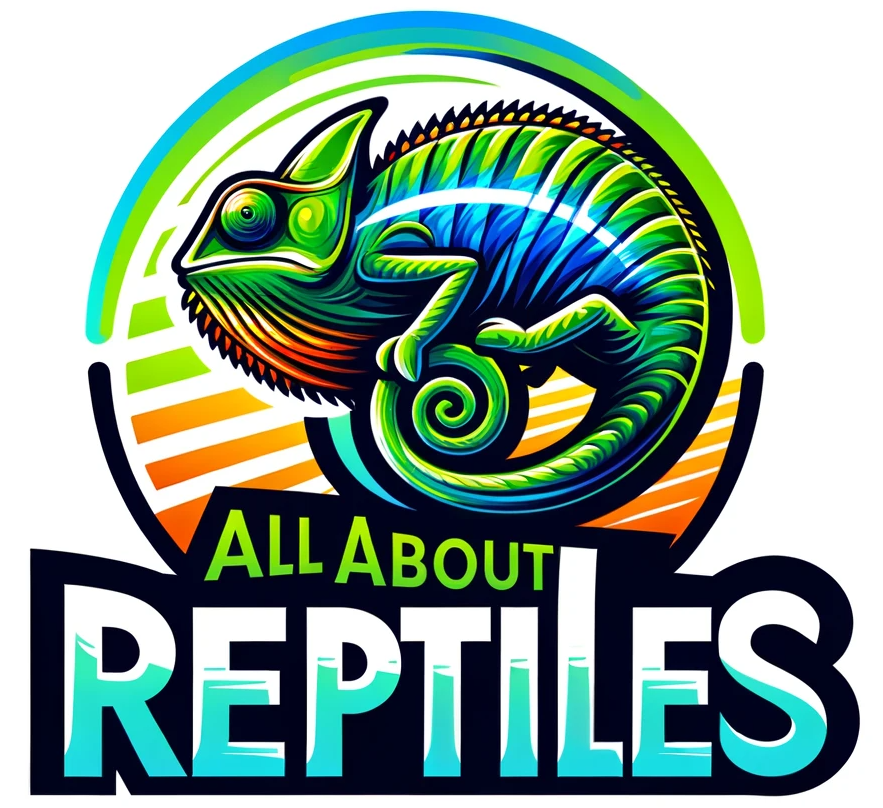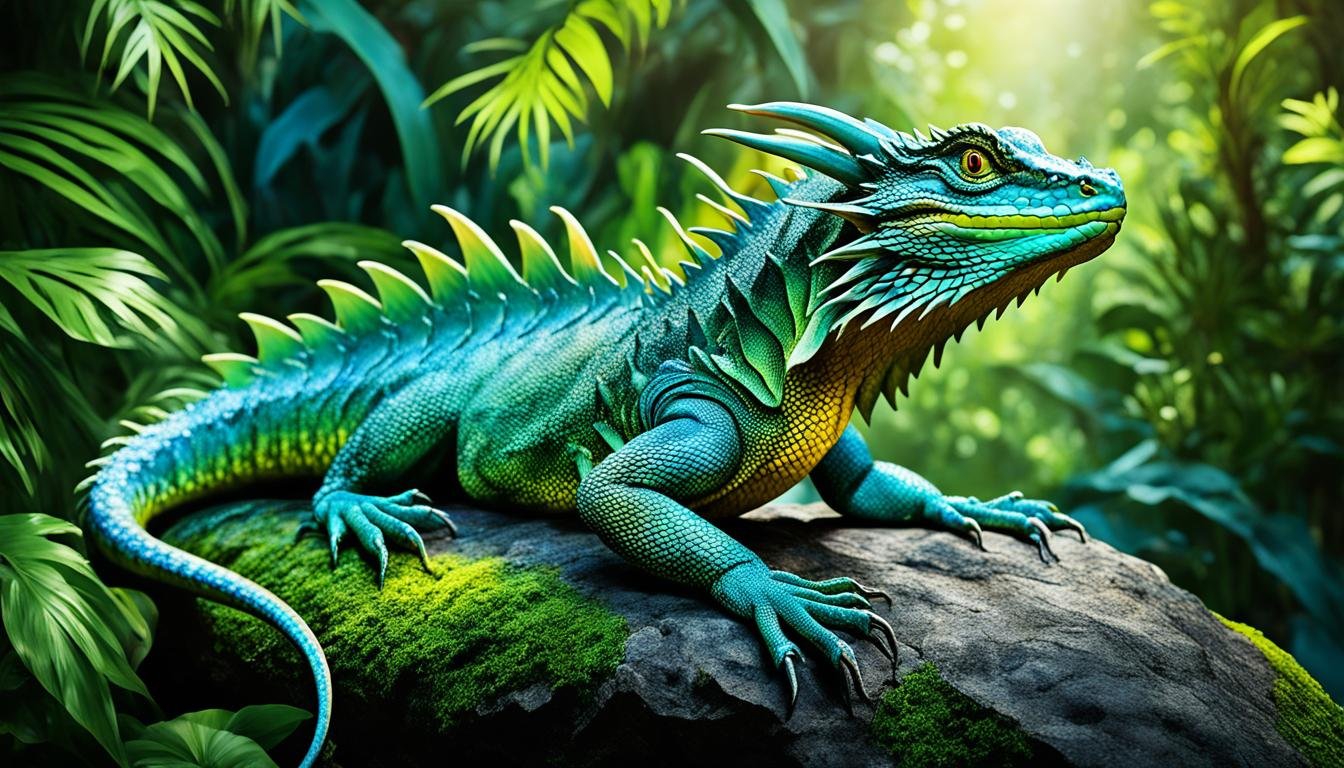Did you know that water dragons have been revered for centuries in dragon symbolism and mythology? These fascinating aquatic dragons, also known as Chinese or Asian water dragons, have captured the imaginations of people around the world. With their vibrant green color, arboreal nature, and unique characteristics, water dragons make captivating pets for reptile enthusiasts.
Key Takeaways:
- Water dragons, also known as Chinese or Asian water dragons, are bright green lizards native to tropical rainforests.
- Male water dragons are larger than females, and it is advised to avoid housing males together.
- Water dragons can change color from green to brown based on environmental conditions.
- Proper care involves providing a suitable habitat, maintaining temperature and humidity levels, and offering a balanced diet.
- Regular veterinary check-ups are essential for ensuring the health and well-being of water dragons.
Water Dragon Characteristics
Water dragons, also known as aquatic dragons, exhibit unique characteristics that make them fascinating reptilian companions. Here, I will discuss their average lifespan, size, diet, and specific traits that set them apart.
Lifespan
With proper care, water dragons can live up to 15 years. Providing a suitable habitat, balanced nutrition, and regular veterinary check-ups are crucial for promoting their longevity and well-being.
Size
Water dragons can grow to be 2-3 feet in length, with males typically larger than females. Their long tails make up about 70% of their total length. It’s important to consider this size when selecting an appropriate habitat.
Diet
Water dragons are omnivorous, meaning they consume both animals and plants. In their natural habitat, they feed on a variety of insects, such as crickets, mealworms, and grasshoppers. Fruits and vegetables, including blueberries, sweet potatoes, and collard greens, should also be included in their diet to provide essential nutrients.
Special Traits
Handling water dragons requires special care. It is important to avoid gripping or lifting them by their tails, as they are prone to tail breakage when threatened. Additionally, water dragons possess a parietal eye on the top of their heads, which aids in temperature regulation and the detection of light variations.
Now that you have a better understanding of water dragon characteristics, let’s explore the essential supplies needed to provide them with a comfortable and enriching habitat.
| Characteristics | Details |
|---|---|
| Lifespan | Up to 15 years with proper care |
| Size | 2-3 feet in length, with males being larger |
| Diet | Omnivorous – insects, fruits, and vegetables |
| Special Traits | Avoid tail handling; possess a parietal eye for temperature regulation and light detection |
Water Dragon Supply Checklist
To properly care for a water dragon, you will need to have the following supplies:
- A suitable habitat: Choose a tall, vertically oriented enclosure with a fitted screen lid for proper ventilation.
- A heat source: Provide an incandescent light or ceramic heater to maintain the ideal temperature in the habitat.
- UV lighting: Install UV lighting to ensure your water dragon receives the necessary UVB rays for vitamin D production.
- A water dish: Make sure the water dish is large enough for your water dragon to soak and swim in comfortably.
- A substrate: Opt for a substrate that can retain moisture well, such as sphagnum moss or coconut fiber. This will help maintain the proper humidity levels in the enclosure.
- Décor and accessories: Create a stimulating and naturalistic environment for your water dragon by adding various decorations and accessories, such as branches, rocks, and foliage.
Having these supplies on hand will ensure that you can provide your water dragon with a comfortable and enriching habitat.
Take a look at the table below for a visual summary of the water dragon supply checklist:
| Supply | Description |
|---|---|
| Suitable Habitat | Tall, vertically oriented enclosure with a fitted screen lid for ventilation |
| Heat Source | Incandescent light or ceramic heater |
| UV Lighting | Provides necessary UVB rays for vitamin D production |
| Water Dish | Large enough for soaking and swimming |
| Substrate | Sphagnum moss or coconut fiber for moisture retention |
| Décor and Accessories | Branches, rocks, foliage, and other items for a stimulating environment |
Water Dragon Handling
When it comes to handling water dragons, proper techniques and gentle approach are crucial. These magnificent creatures can become personable if handled frequently as juveniles, but it’s essential to keep in mind that they are easily frightened. To ensure a positive interaction and minimize stress, I recommend following these guidelines:
- Approach with care: Never approach a water dragon from behind or try to pick it up without warning. This can startle the dragon and may result in defensive behaviors.
- Build trust: Start by allowing the water dragon to become familiar with your presence. Spend time near their enclosure talking softly and moving slowly.
- Gentle touch: When handling, support the water dragon’s body with both hands, avoiding any sudden movements. Keep a firm but gentle grip without applying too much pressure.
- Handwashing is crucial: As with any reptile, proper hygiene is essential. Remember to wash your hands thoroughly before and after handling a water dragon to prevent the transmission of infectious diseases.
To visually reinforce the water dragon handling guidelines, refer to the table below:
| Handling Guidelines | Key Points |
|---|---|
| Approach | Avoid approaching from behind or surprising the water dragon. |
| Build Trust | Allow the water dragon to become familiar with your presence. Avoid sudden movements and loud noises. |
| Gentle Touch | Support the water dragon’s body with both hands. Avoid squeezing or mishandling them. |
| Handwashing | Wash your hands thoroughly before and after handling a water dragon to prevent the spread of diseases. |
Proper handling of water dragons not only establishes trust but also helps in fostering a bond between the owner and the dragon. Remember, patience and respect are key when interacting with these majestic creatures.
Water Dragon Habitat Recommendations
Creating the ideal habitat for your water dragon is essential to ensure their well-being and happiness. These arboreal creatures require a tall, vertically oriented enclosure that mimics their natural environment. Glass enclosures are recommended over open-air or screen habitats as they help maintain proper humidity levels and temperature gradients.
As your water dragon grows, it’s important to gradually increase the size of their habitat to accommodate their needs. This will allow them ample space to climb, explore, and exercise.
The enclosure should include visual barriers, such as plants or decorations, to prevent nose rubbing and provide a sense of security for your water dragon. Additionally, providing plenty of climbing opportunities with branches and perches will allow them to showcase their arboreal nature.
Another crucial element of their habitat is a water dish large enough for soaking and swimming. Water dragons are semi-aquatic creatures, and providing a suitable water source is vital for their overall health and hygiene.
Choosing the right substrate is also important. Opt for materials that can hold moisture well, such as sphagnum moss or coconut fiber. These substrates not only help maintain proper humidity levels but also provide a comfortable and naturalistic environment for your water dragon.
Water Dragon Habitat Recommendations:
| Aspect | Recommendation |
|---|---|
| Enclosure Type | Glass enclosure |
| Habitat Size | Gradually increase as the dragon grows |
| Visual Barriers | Plants or decorations to prevent nose rubbing |
| Climbing Space | Branches and perches |
| Water Dish | Large enough for soaking and swimming |
| Substrate | Sphagnum moss or coconut fiber |
Water Dragon Temperature and Lighting
Proper temperature and lighting are essential for the well-being of water dragons. These reptiles require a temperature gradient in their habitat to regulate their body temperature effectively.
During the day, water dragons need a basking spot with a temperature ranging from 95-100°F. This warm area allows them to thermoregulate and aids in digestion. The rest of the habitat should have cooler zones with temperatures set to 80-85°F. At night, the temperature should not drop below 75°F. Maintaining appropriate temperature levels is crucial for the overall health and comfort of your water dragon.
Heat sources such as incandescent lights or ceramic heaters can be used to provide the necessary warmth in the habitat. They help mimic the natural basking environment and ensure the water dragon’s thermoregulation needs are met.
In addition to heat, water dragons require UV lighting to fulfill their vitamin D requirements. UVB rays are crucial for calcium absorption and preventing metabolic bone disease. It is recommended to use a full-spectrum UVB light specifically designed for reptiles. However, it’s important to note that white lights should not be left on continuously, as water dragons require a proper day and night cycle. A night timer can be used to simulate natural light patterns.
To summarize:
- Basking temperature: 95-100°F
- Cool zone temperatures: 80-85°F
- Nighttime temperature: Above 75°F
- Heat sources: Incandescent lights or ceramic heaters
- UV lighting: Full-spectrum UVB light
- Day and night cycles: Use night timers
Providing the correct temperature gradient and suitable lighting conditions is vital for the overall health, well-being, and proper physiological functioning of your water dragon.
Water Dragon Humidity and Substrate

Proper humidity is essential for the health and well-being of water dragons. These tropical reptiles require moderately high humidity levels of 70-80% in their habitat to thrive. Maintaining the correct level of humidity can be achieved through regular misting and providing a shallow water dish for soaking.
To maintain the desired humidity, it is recommended to mist the walls, plants, and décor inside the enclosure daily with warm water. This allows water droplets to settle on the surface, creating a humid environment that closely mimics the natural habitat of water dragons.
Additionally, offering a shallow water dish in their habitat provides the water dragons with an opportunity to soak and regulate their hydration levels. The dish should be large enough for them to comfortably immerse themselves, allowing them to absorb water through their skin.
When it comes to choosing the substrate for the habitat, it is crucial to select options that hold moisture well. Sphagnum moss and coconut fiber are excellent choices as they retain water effectively, contributing to the maintenance of the proper humidity levels. Gravel, wood chips, and walnut shells should be avoided, as they not only have a low moisture-holding capacity but can also cause gastrointestinal problems if ingested by the water dragons.
Key Points:
- Water dragons require humidity levels of 70-80% in their habitat.
- Mist the walls, plants, and décor with warm water daily to maintain proper humidity.
- Provide a shallow water dish for water dragons to soak in and regulate their hydration.
- Choose substrates like sphagnum moss or coconut fiber that retain moisture well.
- Avoid gravel, wood chips, and walnut shells as substrates, as they can cause gastrointestinal issues if ingested.
Water Dragon Diet
Proper nutrition is crucial for the health and well-being of water dragons. As omnivores, they require a balanced diet that consists of both insects and fruits/vegetables. Understanding the dietary needs of water dragons is essential to ensure their optimal growth and vitality.
Foods for Nutrition
Water dragons should be fed a diet consisting of approximately 85-90% insects and 10-15% fruits and vegetables. Live insects are an essential part of their diet and can include crickets, mealworms, and grasshoppers. These provide the necessary protein and essential nutrients.
In addition to insects, it’s important to offer a variety of fruits and vegetables. Some examples include:
- Blueberries: Rich in antioxidants and vitamins
- Sweet potatoes: High in fiber and vitamin A
- Collard greens: Excellent source of calcium and vitamin K
By offering a diverse range of foods, water dragons can obtain a well-rounded nutritional profile that supports their overall health.
| Insects | Benefits |
|---|---|
| Cricket | High in protein and fiber |
| Mealworm | Good source of fat and protein |
| Grasshopper | Rich in vitamins and minerals |
It’s important to note that water dragons have specific dietary needs, and it is recommended to consult with a reptile veterinarian or a knowledgeable reptile specialist to ensure the diet meets their nutritional requirements.
Remember to provide fresh, clean water at all times. Water dragons should have access to a large water dish in their enclosure for soaking and hydration.
Overall, a balanced and varied diet is crucial for the health and well-being of water dragons. By offering a combination of live insects and a variety of fruits and vegetables, pet parents can ensure their water dragons receive the necessary nutrients for a long and healthy life.
Water Dragon Health

Ensuring the health and well-being of your water dragon is of utmost importance. Like any living creature, water dragons are susceptible to certain health issues that require attention and care. Common health concerns in water dragons include:
- Mouth Rot: This condition, also known as infectious stomatitis, is characterized by inflammation and infection in the mouth and gums. It can be caused by improper hygiene, poor diet, or bacterial/fungal infections.
- Nutritional and Metabolic Disorders: Metabolic bone disease is a common disorder in reptiles, including water dragons, caused by a lack of calcium and vitamin D3. It can lead to weakened bones, deformities, and even death.
- Infectious Diseases and Parasites: Water dragons can be affected by various infectious diseases and parasitic infestations. These can include bacterial, viral, and fungal infections, as well as external and internal parasites such as mites and worms.
- Skin Infections: Water dragons are prone to skin infections, especially if their habitat and enclosure are not properly maintained. Bacterial and fungal infections can cause skin lesions, discoloration, and discomfort in the reptile.
To keep your water dragon in good health, it is essential to practice proper hygiene, schedule regular check-ups with a reptile veterinarian, and maintain a clean and suitable habitat. Regular cleaning of the enclosure, including removing any waste or uneaten food, is important to prevent the growth of bacteria and fungi. Additionally, providing a well-balanced diet rich in calcium and vitamin D3 is crucial for preventing metabolic bone disease.
By staying vigilant and proactive in monitoring your water dragon’s health, you can ensure a long and fulfilling life for your aquatic companion.
Popular Varieties
While there are no recognized subspecies of Chinese water dragons, they are sometimes referred to as Asian, Green, or Thai water dragons. They are known for their unique appearance, including bright green coloration with blue stripes, yellow highlights, and pink tones along the lower chin-shield scales. While there are no official morphs, some variations in color may occur, such as aqua, bright green, and blue, but these are not considered official morphs.
Chinese water dragons, also known as Asian, Green, or Thai water dragons, are characterized by their vibrant green coloration with blue stripes, yellow highlights, and pink tones along the lower chin-shield scales. Although they are not officially recognized as distinct subspecies, these variations in color create a captivating and visually stunning appearance.
Chinese Water Dragon Size and Lifespan
Chinese water dragons, also known as aquatic dragons, are fascinating reptiles that can grow to an average length of 3 feet. Males tend to be larger than females, showcasing their impressive size and presence. One remarkable characteristic of water dragons is that their tail makes up about 70% of their total length, making it a prominent feature of their appearance.
With proper care and a suitable environment, Chinese water dragons can live an average lifespan of 10-15 years. However, some individuals have been known to exceed expectations and reach up to 20 years of age. This emphasizes the importance of offering these beautiful creatures the ideal conditions and attention they deserve.
| Dragon Species | Average Length | Male Size | Average Lifespan |
|---|---|---|---|
| Chinese Water Dragon | 3 feet | Larger | 10-15 years |
It’s truly fascinating to witness the growth and longevity of Chinese water dragons as they thrive in the right circumstances. The bond formed with these captivating creatures can last for many years, providing endless joy and wonder.
Investing time and effort into understanding the specific needs of Chinese water dragons can significantly contribute to their overall well-being and longevity. Creating a suitable habitat, offering a balanced diet, and ensuring regular veterinary check-ups are key to providing these remarkable creatures with a fulfilling and healthy life.
Conclusion
Caring for a water dragon requires commitment, proper husbandry, and a well-maintained habitat. By providing the right environmental conditions, a balanced diet, and regular veterinary check-ups, you can ensure the health and well-being of your water dragon. These captivating and vibrant aquatic companions have unique characteristics and symbolism that make them a popular choice for reptile enthusiasts.
Water dragons, also known as aquatic dragons, are diurnal reptiles that thrive in tall, vertically oriented enclosures. Their arboreal nature calls for ample climbing space and a suitable heat source to maintain proper temperature gradients. Additionally, the humidity levels must be carefully maintained to support their need for moist environments.
When it comes to feeding, water dragons are omnivores and require a varied diet, consisting mainly of insects with a smaller portion of fruits and vegetables. The balanced nutrition helps ensure their overall health and prevents common issues such as metabolic bone disease. Regular veterinary check-ups and a clean habitat further contribute to their well-being.
With the proper care and knowledge, water dragons can become fascinating companions, showcasing their vibrant coloration and charming behavior. Whether drawn to their dragon symbolism, their aquatic nature, or their unique characteristics, water dragons can provide reptile enthusiasts with a captivating experience that lasts for many years to come.
FAQ
Are water dragons suitable pets?
How long do water dragons live?
What do water dragons eat?
How big do water dragons grow?
Do water dragons require a specific habitat?
How should water dragons be handled?
What supplies do I need to care for a water dragon?
How do I maintain the right temperature and lighting for water dragons?
How do I create the right humidity and substrate for water dragons?
What are common health issues in water dragons?
Can water dragons be housed together?
What are some popular varieties of water dragons?
References
| Organization Name | URL |
| International Reptile Conservation Foundation (IRCF) | https://www.ircf.org/ |
| Herpetological Conservation International | https://herpconservation.com/index.html |
| Society for the Study of Amphibians and Reptiles (SSAR) | https://ssarherps.org/about-ssar/ |


2 thoughts on “Caring for Your Water Dragon: Tips & Insights”